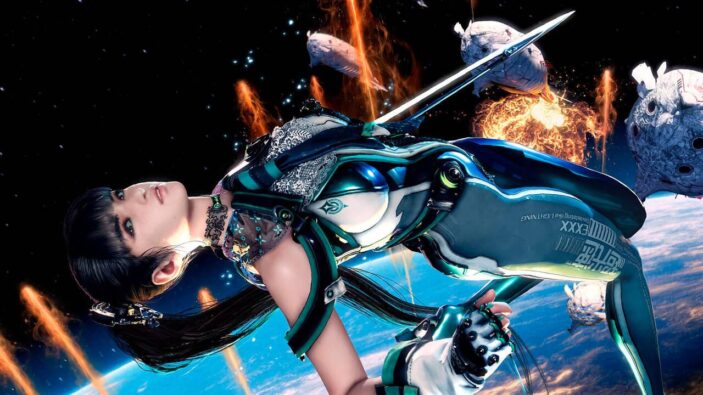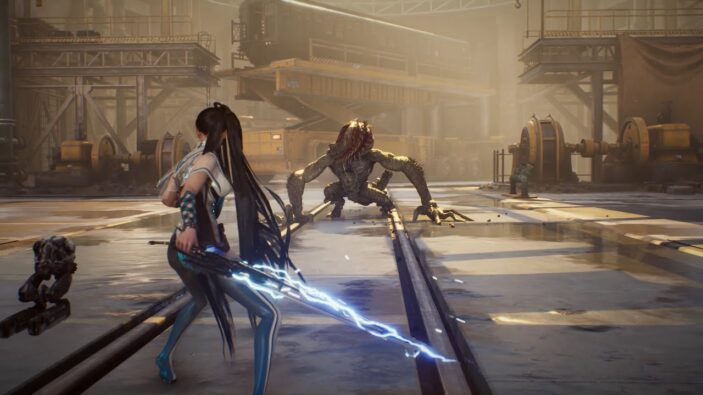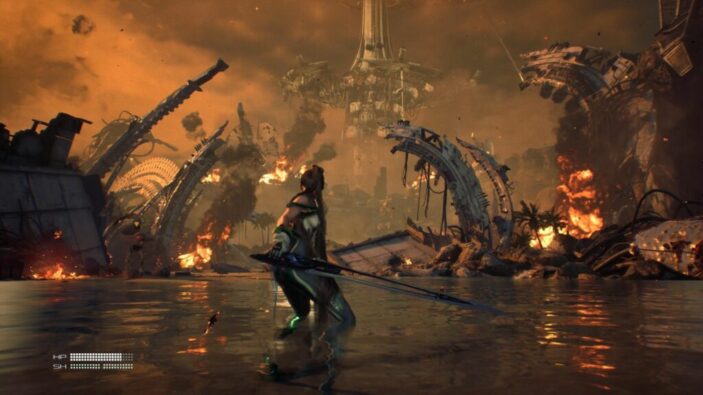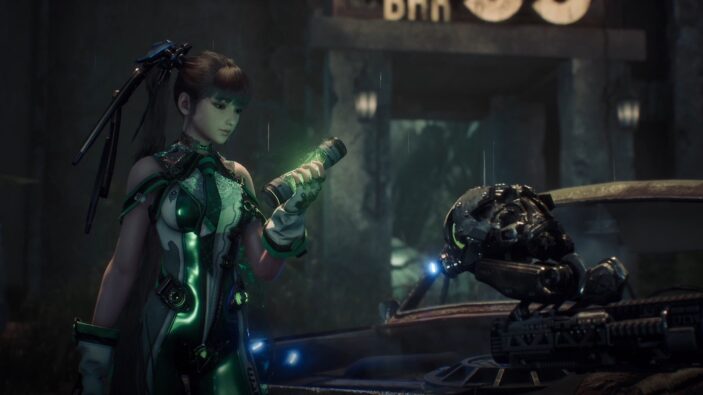
Stellar Blade caught my eye a few months ago for its dazzling visuals and downright bonkers gameplay. It was something fresh, yet familiar, with developer Shift Up drawing on a number of inspirations from the hack-and-slash genre. While Stellar Blade’s story is either tired or outright ridiculous at the best of times, it absolutely shines in delivering some of the most polished and satisfying combat out there today.
I wouldn’t necessarily criticise its gameplay elements for feeling familiar, as they’re so functional, but I also can’t deny that when Stellar Blade takes steps to deviate from the norm through its narrative, it largely misses the mark.
Reporting for Duty
Players take on the role of Eve, a soldier of the Airborne Squad 7 regiment, who is called to Earth to eradicate a new alien threat known as the Naytibas. These aliens essentially wipe out Eve’s squad, forcing her to retreat and regroup with a new plan. She must hunt down and collect four distinct hypercores, and with some new supporting characters, discover the true origin of this threatening alien race.
I don’t think there’s anything necessarily terrible about the story, but it just feels dull at times. Voice acting across the board is decent too, but the characters don’t really bring any emotional stakes to the table. Eve is certainly the most fleshed out, and it’s nice to see the story dive into her own origins and ambitions in the process, but it doesn’t really make up for the lack of context the rest of the story is guilty of.

While the 20-25-hour story can drag at times, Stellar Blade is thankfully always focused on the action. Cutscenes don’t really last that long, and there’s generally a fair amount of exposition at every turn, to keep players informed. I just wish it was as constantly engaging as the gameplay, as it’s generally flaunting a decent mystery that I wish was handled a little better.
Strike First
The moment-to-moment gameplay is where Stellar Blade truly shines. It’s slick, responsive and downright satisfying, packed with variety and doused in style. I can imagine Stellar Blade’s combat will be compared to a Souls-like game like Sekiro: Shadows Die Twice for its pace and general mechanics, but it’s certainly not as difficult. It definitely packs a punch when it comes to its main boss fights but feels much breezier when you’re up against regular enemies.
Eve can utilise a combination of light and heavy melee attacks while dodging and blocking, which feel about as great as you would expect from any critically acclaimed Souls-like. It really does feel that good. Attacks can also be parried at the right time, while some having to be dodged altogether. The latter of which come about more frequently when fighting larger enemies, but it all breaks up combat variety nicely. Eve can also dish out special Beta Skills, which use Beta Energy gained via combat to deliver powerful attacks.

Throughout the campaign, however, Eve will also unlock a bunch of new weapons and tools to use in combat, which keeps things feeling fresh almost the entire way through. With a wrist-mounted drone that can fire various types of ammunition to affect different enemy types, it’s consistently satisfying to have this much in your arsenal to mix and experiment with at any given time.
Eve will also be able to use Burst Skills, which act like Beta Skills but take much longer to earn and generally yield more devastating results. It’s fun to have to balance your energy meter and choose when and where to act. If you’re in immediate danger, a Burst Skill might save the day, but you’ll then need to rely on your traditional combat skills for a longer period of time moving forward.

If that wasn’t enough, players can gain EXP to flesh out multiple skill trees to unlock a bunch of new abilities. Three distinct skill trees allow Eve to improve her attacks, general survival skills, and Beta Energy abilities, all of which can contribute to multiple unique playstyles. While I think a balanced approach is the way to go, each time spending an upgrade point felt like a tough choice between gaining a new ability, and putting an equally exciting option on the backburner.
Overall, combat is fast, frenetic and fluid, complete with a bunch of ways to upgrade and play. It’s also incredibly balanced, and thanks to the Beta Energy system that powers your Beta Skills and Burst Skills, makes most larger and tougher battles feel like a game of risk and reward as you refine your approach. While it doesn’t feel as difficult at times, it does feel consistently fresh throughout its 25-hour runtime.
The World Beyond
If you’re looking to stray off the beaten path, Stellar Blade provides a few open areas to explore, complete with some light platforming and environmental puzzle-solving. You’ll swing across chasms and figure out how to reach ladders, and while none of it feels too challenging or in-depth, I appreciate it for the sake of variety. As most of the experience feels linear at times, I strongly recommend taking the chance to explore whenever possible.
Eve will also be able to partake in some light side activities along the way, generally assigned from a bulletin board or from local NPCs. They only really amount to light fetch quests and targets to eliminate, but they’re generally easy enough to track down and compete. In turn, Eve will earn EXP to spend on upgrades, and Gold, which is used for refilling consumables. Unfortunately, Gold becomes useless later on as you’ll find most of what you need upfront, but these side quests are certainly worth it for the EXP alone.

While exploring, collectible items like cans can be found to unlock a bunch of goodies, as well as specific parts that can boost Eve’s health and energy perpetually. As many would have expected, Eve can also unlock a range of 30 outfits to shake things up, even if most of them feel gratuitous for the sake of it. I’m sure you’ve seen a few clips of Eve’s figure in some suggestive clothing, and the conversation will only deepen here, as you can imagine.
Look the Part
Running on Unreal Engine, developer Shift Up has admittedly done a great job for their first premium triple-A title, serving up something that looks great and runs relatively well. Textures are super polished, lighting is decent and environments and character models look fleshed out. The frame rate leaves a little to be desired, as it can drop in busier areas of the game, although nowhere near enough to leave a lasting negative impact.
The dedicated Resolution mode is capped at 30fps and delivers a 4K resolution, but feels a little too sluggish for this type of action. The Performance mode runs at 60fps targeting a 1440p resolution, and fares much better, removing almost all significant frame rate drops. There is a Balanced mode, which targets 60fps and a 4K resolution, but this is highly dependent on the setting and situation and will fluctuate rather constantly. The resolution wasn’t really a dealbreaker, but the frame rate fluctuations are certainly more noticeable here.
Final Thoughts
Throughout its unfortunately dull story, Stellar Blade does its best to remind players that it’s providing out some of the best hack-and-slash action out there today. The game should be enjoyed primarily for its combat and overall gameplay, with developer Shift Up having one of the most impressive first cracks in recent memory.
While it can also feel linear at times, the ability to upgrade, discover and broaden the horizons of combat and overall mechanics throughout a 25-hour experience is something to admire. Stellar Blade is without a doubt worth playing if you’re a fan of something like Sekiro: Shadows Die Twice for its combat, but given its more forgiving nature, something I would recommend to almost any PlayStation 5 owner.
FOUR STARS (OUT OF FIVE)
Highlights: Engaging combat; Deep progression systems; Slick visuals
Lowlights: The story is a little dull at times, and lacks any real emotional stakes
Developer: Shift Up
Publisher: Sony Interactive Entertainment
Platforms: PlayStation 5
Available: Now
Review conducted on PlayStation 5 with a code provided by the publisher.
